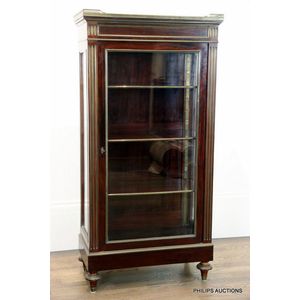Louis XVI Style Mahogany Vitrine with Brass Trim
You must be a subscriber, and be logged in to view price and dealer details.
Subscribe Now to view actual auction price for this item
When you subscribe, you have the option of setting the currency in which to display prices to $Au, $US, $NZ or Stg.
- Gallery - On furniture, a gallery is a small upright section, frequently pierced and decorated, around the tops of small items of furniture, such as davenports, side tables, and so forth. Galleries are made in brass or bronze,and be fretted, pierced or solid timber. A three-quarter gallery is one that surrounds three of the four sides of a table, desk or other top.
- Mahogany - Mahogany is a dense, close grained red-coloured timber from the West Indies and Central America. It was first imported into Europe in the the early 18th century and its use continued through the 19th century. It was popular for furniture making because of its strength, the wide boards available, the distinctive grain on some boards, termed flame mahogany and the rich warm colour of the timber when it was polished.. The "flame" was produced where a limb grew out from the trunk of the tree, and this timber was usually sliced into veneers for feature panels on doors, backs and cornices.
Some terms used to describe mahogany relate to the country from which it originally came, such as "Cuban" mahogany, "Honduras" mahogany etc. However unless the wood has been tested the names assigned are more a selling feature, rather than a true indication of the timber's origin. - Stile - A cabinetmaker's term that refers to the vertical end members of the framework in a panelled item of furniture. The vertical mid-members are known as muntins.
- Fluting - A form of decoration found on many pieces of furniture, as well as ceramics, silver and clocks, in which round-bottomed grooves, of varying width and depth, are let into columns, pilasters, legs. As a general rule, flutes are cut in the vertical, though they may follow a turned leg in a spiral pattern. In cross-section, they may be described as a series of 'U' shapes, rising and narrowing at each end of the groove. Fluting is the opposite of reeding, with which fluting is often associated.
This item has been included into following indexes:
Visually similar items

A French brass mounted mahogany vitrine with a single door, beneath a gallery edged marble top, applied brass strap work, 70 x 140.5 x 36.5 cm

A Regence oak display cabinet, 20th century, a full length part glazed cupboard with shelving, the upper register with a framed surround centred with a carved vegetal motif, a fielded panel of conforming design below, with curved edges, a shaped apron with

A French Empire style kingwood bookcase cabinet inlaid cupboard and two side cupboards, gilt metal mounts. Height 64 cm. Width 140 cm. Depth 44 cm

A Louis XV style walnut and Elmwood display cabinet circa 1940, a simple moulded pediment above a single full length door, part glazed, the lower section in burr walnut, embellished with scrolls and central palmettes, with three shelves and a cupboard, a d
